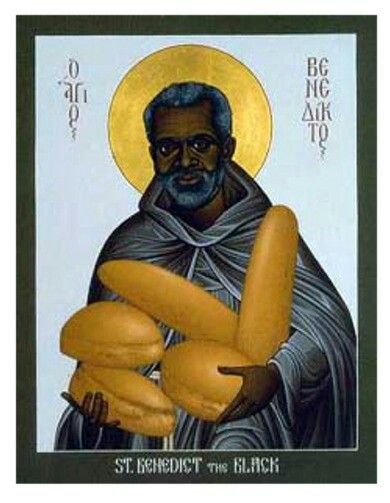
About the Commemoration
St. Benedict the Black (Benedict the Moor) is remembered on this date on the Roman Catholic calendar, and on the calendar in Evangelical Lutheran Worship as Benedict the African.
Benedict was born near Messina, Italy, in 1526, the son of slaves who had been taken to Italy and later became Christians. He worked as a field hand until he was eighteen, when he was given his liberty. For the next ten years he made his living as a day laborer, sharing his meager wages with the poor and devoting much of his leisure time to the care of the sick. Although his race and his parents’ servitude made him the object of frequent ridicule, he bore the humiliation with impressive dignity. His gentle replies to his tormenters attracted the attention of Jerome Lanzi, a young man who had withdrawn from the world to imitate the life of Francis of Assisi. Benedict joined Jerome’s group of hermits. After Jerome died, Benedict reluctantly became their superior. When Pius IV directed all independent groups of hermits to affiliate with established religious orders, Benedict became a Franciscan lay brother. He worked for a number of years as a cook at the Friary of St. Mary of Jesus in Palermo. Domestic duties gave him opportunity to perform small acts of charity, well suited to his retiring nature.
In 1578 the illiterate lay brother was appointed guardian of the Friary, and he proved to be an ideal superior. His reputation for sanctity spread, and he chose to travel at night or in the daytime with his face covered. His ability to expound Scripture was impressive and his intuitive understanding of theological questions astonished scholars. Toward the end of his life he asked to be relieved of his duties as superior in order to return to the kitchen. He died at Palermo April 4, 1589, and was buried in the friary church. In 1611 the Spanish king Philip II donated to the church a shrine where Benedict’s remains continue to be venerated.
Benedict the Black may be commemorated in conjunction with Martin Luther King Jr., one set of propers serving for both. If a separate remembrance is desired, his commemoration may be transferred to the following day.
Excerpts from New Book of Festivals & Commemorations: A Proposed Common Calendar of Saints by Philip H. Pfatteicher, copyright, 2008 by Fortress Press, an imprint of Augsburg Fortress.
See also: Benedict the Moor
Preface: Saint (2)
Color: White
